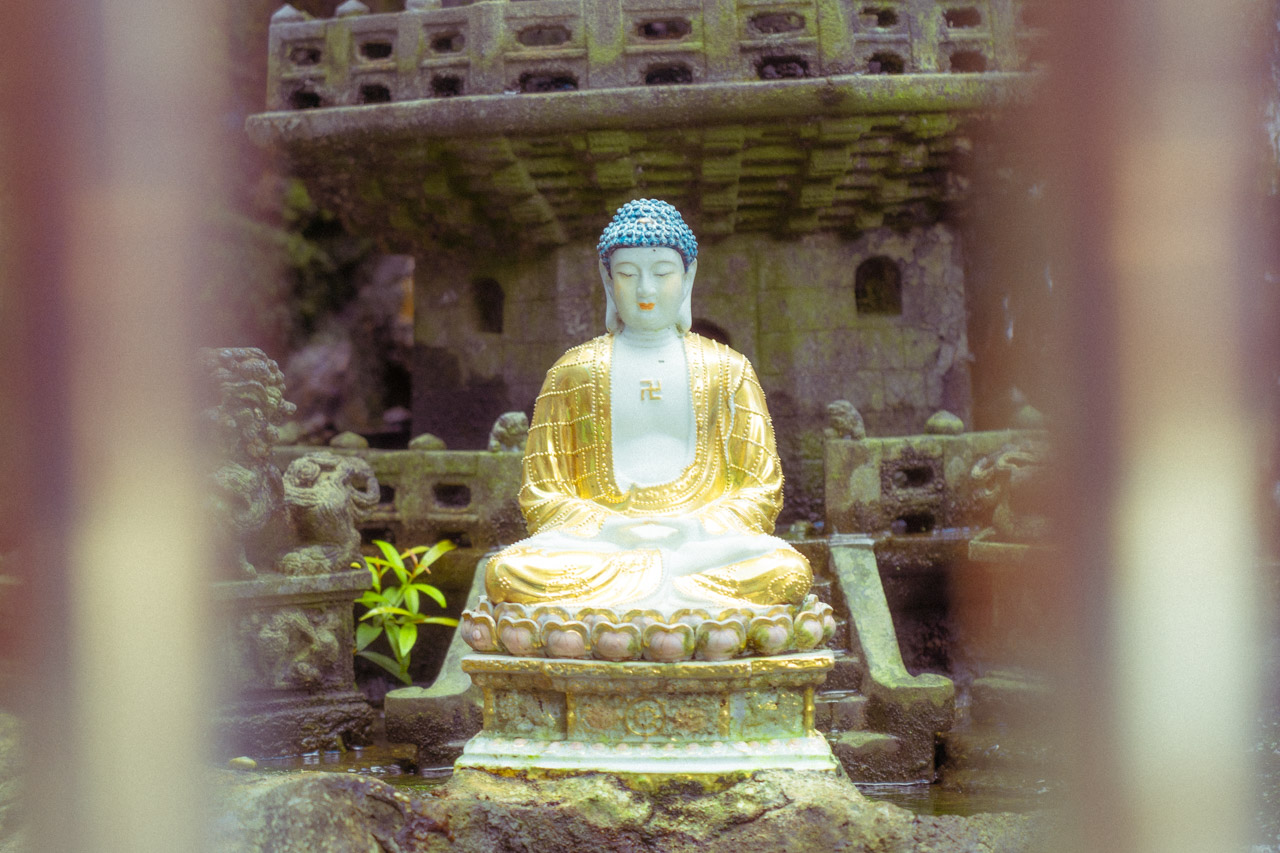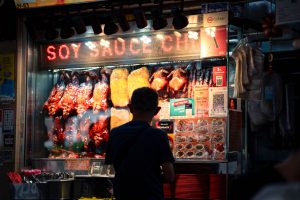All images by Thaddeus Loh unless otherwise stated.
Constructive discussions on faith and ethnicity can be tough when folks lack an understanding of cultural practices. So for this entire month, we’re exploring the history and use of religious artefacts across different religions in Singapore.
After exploring the symbolism and iconography involved in Hinduism, Sikhism, Islam, Catholicism and Christianity, we now take a look at Buddhist and Taoist religious amulets.
Protective amulets have a vivid presence in the Singaporean cultural imagination. In B-grade Chinese horror movies, protagonists jab amulets on the heads of stiff-legged jumping zombies to subdue them. Television shows depict amulets as being capable of anything from summoning spirits to controlling the forces of nature.
While nothing so dramatic occurs in daily life, the use of amulets among many Taoist and Buddhist Singaporeans is ubiquitous. As kiasu—and kiasi—Singaporeans, we, very understandably, want to surround ourselves with blessings and protect ourselves from physical harm and ill luck, regardless of religious background.
The trade-off in this liberal acceptance and use of amulets is that most of us are unaware of the origins of these amulets, let alone to which religious tradition they belong. The fanciful depictions of amulets in popular media make it even harder to separate fiction from religious tradition.
Adding to this difficulty is the syncretic character of Chinese religion in Singapore. Simply put, the religion that over 40 per cent of religious Chinese Singaporeans practise is a combination of Buddhism, Confucianism, and Taoism.
However, far from being a confusing hodgepodge of discrete practices and competing worldviews stitched together, this intermingling of religions in Singapore—brought here by our early ancestors who immigrated from all over China— has resulted in a unique, hybridised form of religion known as “Chinese religion”. [1]
To help me untangle the complexities of amulet usage in different religions among Singaporeans, I visited a religious centre and a temple to seek guidance from the authorities and scholars there.
My first stop is Gaden Shartse Dro-Phen Ling (GSDPL), a Tibetan Buddhist centre located in Geylang. I went bearing questions on what Tibetan Buddhist amulets offer.
Amulets in a Tibetan Buddhist Centre: Gaden Shartse Dro-Phen Ling (GSDPL)

My uncle works in a shipyard. One early morning, at around 5 AM, he reported to work and somehow missed his step when he arrived at the shipyard.
He fell straight into the sea, dragged down by the weight of his shipyard bag.
Suddenly, he felt a force pulling him back up to the surface. It came from nowhere. After emerging from the sea and regaining his composure, he opened his shipyard bag to check if anything was spoilt. In it, he found a Yamantaka Ruel—one of the most powerful amulets in Tibetan Buddhism—that his wife had placed without his knowing.
Nobody can prove that the Ruel had saved his life. But there was nothing else of particular value in his bag.
To this day, my uncle attributes the unknown force that pulled him out of the water to the Ruel.
This account of her uncle’s miraculous rescue was told to me by Jamie Looi, President of Gaden Shartse Dro-Phen Ling (GSDPL), a Tibetan Buddhist centre.
On that warm, lazy afternoon at the centre, I got a crash course in the history and use of Buddhist amulets from Jamie and Geshe Lobsang Chophel, a monk scholar who has attained a Geshe Lharampa degree—equivalent to a PhD, the highest honorific one can be awarded in Tibetan Buddhist philosophy.
According to Geshe-la (a title, and respectfully meaning ‘virtuous teacher’), these amulets originate all the way back to the 5th or 4th century BC, during Buddha’s time. When Buddha was alive and passing down his teachings to his devotees, demonic energies were especially strong as they wanted to prevent humans from attaining nirvana. Buddha thus devised these amulets as a method of protection.
Since then, the notion of protective amulets has been enshrined in Buddhist Vajrayāna scriptures. Through this unbroken lineage of traditional prayer rituals, monks today can continue the practice of consecrating these religious items to bless devotees.
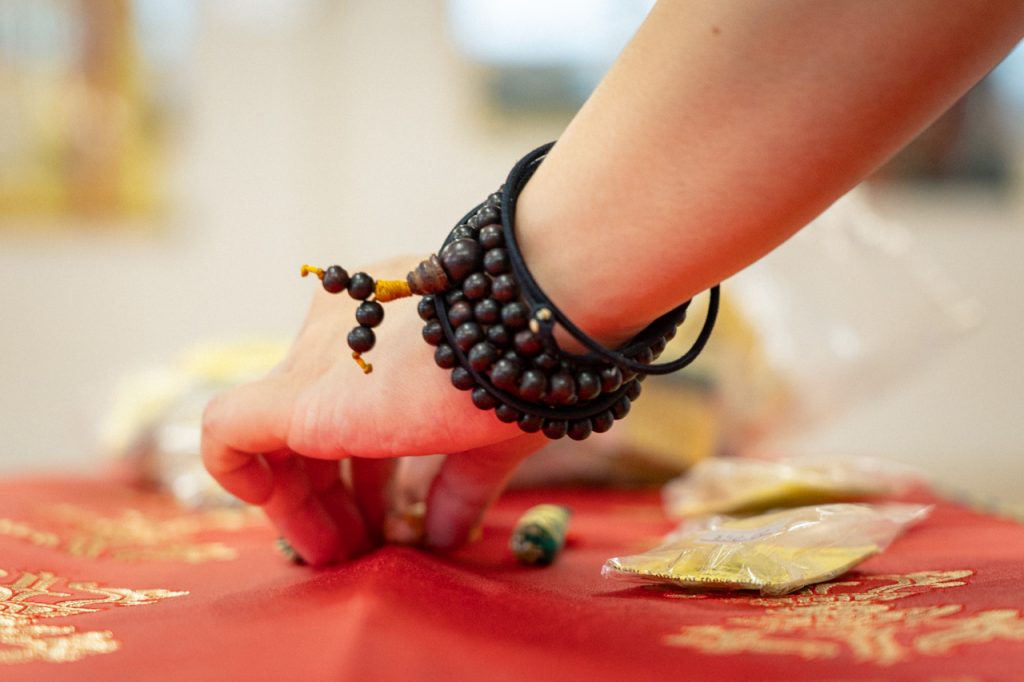
Typically, a Tibetan Buddhism amulet has to fulfil three conditions before it is consecrated: first, mantra; second, meditation; third, substance.
In its rawest form, an amulet is simply a piece of paper on which a mantra—a word or phrase believed to possess sacred power—is printed. To imbue the amulet with its protective power, monks have to meditate and recite the scriptures with devotion and faith. A specific substance, or a mix of substances, is also offered during the prayers to consecrate and activate it. The Ruel, for instance, contains a hammered gold substance that is mined by hand from the soil.
Curious, I ask Geshe-la what other sorts of substances are used in the making of Tibetan Buddhism amulets.
He laughs: “It’s not good to reveal! It’s not that I don’t want to tell you … In Vajrayāna, some secrets have to be kept.”

The amulets available at GSDPL are properly consecrated and blessed by monks in their monastery in India, before they are brought to Singapore by the monks themselves.
She then shows me three amulets that are particularly popular amongst devotees at GSDPL.
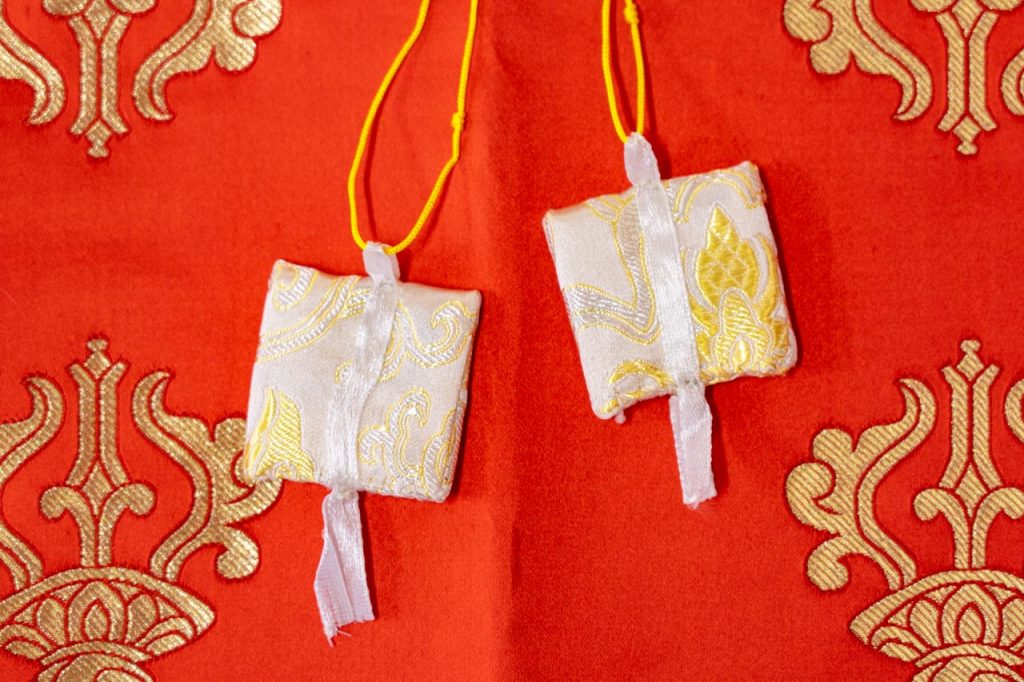
First up is the Dukar Khorlor (also known as the White Umbrella Goddess Amulet), which is “very helpful for the spirit … especially to prevent or overcome spirit harm or possession,” Geshe-la elaborates.
Tibetan Buddhists believe that when people seem out of sorts and behave abnormally, their spiritual energy may be disturbed. In more serious cases, it may even be because “a spirit has entered their body”, says Geshe-la.
Symptoms of this, Jamie says, include waking up in the middle of the night, recurrent nightmares, and insomnia, especially if they happen out of the blue and are prolonged. .
For these cases, people turn to the Dukar Khorlor for protection and to find inner peace.The Dukar Khorlor’s powers in spiritual protection stem from its origin as an amulet blessed by the deity Sitātapatrā. Sitātapatrā, which is Sanskrit for “White (sitā) Umbrella (tapatrā), is a fearless female deity who is identified by her white parasol, her practice protects sentient beings from evil and negative influences.
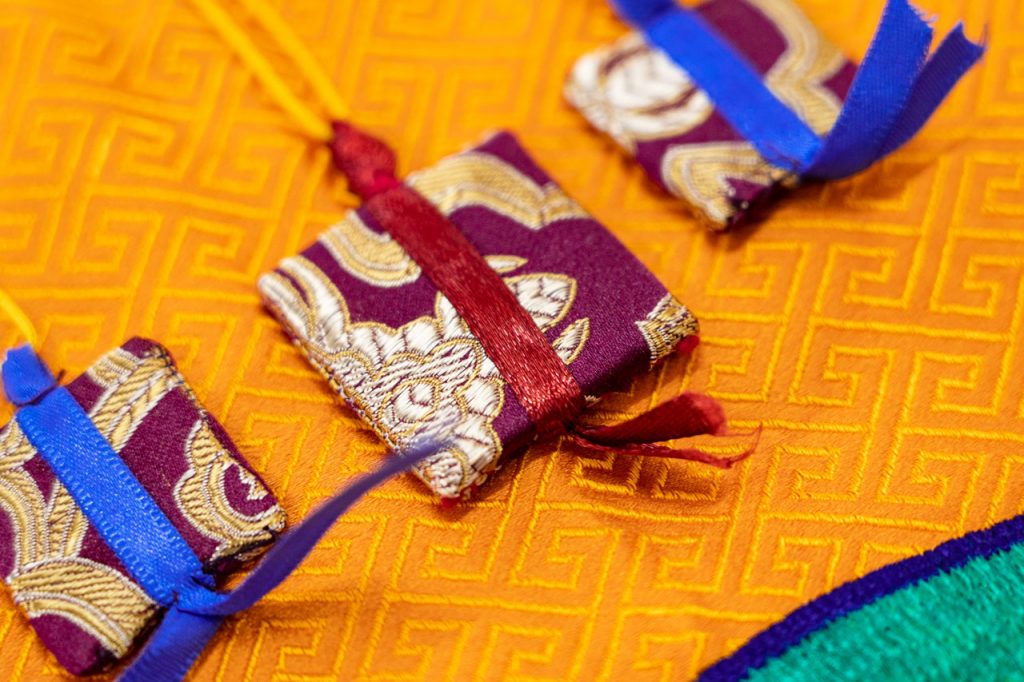
Complementing the Dukar Khorlor’s blessing of the spiritual self is the Soso Danwa, which Geshe-la says “is helpful for many things, but—”
“—mostly for having children!” Jamie completes his sentence, almost mischievously. “There are many benefits associated with this practice, like increasing conditions for likeability, recovery from karmic illnesses, and strengthening physical health, but people mainly use this for fertility.”
“Yes, it really helps,” Geshe-la continues with a smile. He recounts how one of his friends, who had suffered many miscarriages, finally managed to conceive after he gave her the amulet and instructed her to recite mantras.
Jamie shares a similar anecdote: “One of our devotees had three miscarriages in one and a half years. After that, she went to India, visited the monastery, and prayed for blessings. She wore this amulet through the whole of her pregnancy. There were times when the baby became unstable, but she prayed devoutly and the baby stabilised.
“For her fourth pregnancy in the one and a half years, she finally managed to have a cute fat baby boy. It’s a blessing.”

Jamie then brings out the amulet that saved her uncle’s life: the Yamantaka Ruel, one of the most powerful amulets in Tibetan Buddhism. Devotees believe that the Ruel protects its bearer from ill health or recurrent bouts of failure brought about by black magic or paranormal influences.
For many, their belief in the Ruel’s efficacy lies not in mere faith, but real-life accounts. Aside from her uncle’s experience, Jamie has personally witnessed many instances in which the Ruel seemed to have prevented an accident or injury that could have gone horribly wrong.
“That’s why the Ruel is one of the most popular amulets in the centre,” Jamie concludes. “A lot of believers come to our centre to buy these amulets.”
(Usually, anyone is free to walk in to GSDPL to purchase an amulet. But because of Covid, pre-registration is required.)
“They cost between $20 to $50, and all the proceeds will go towards supporting the Buddhist centre.”
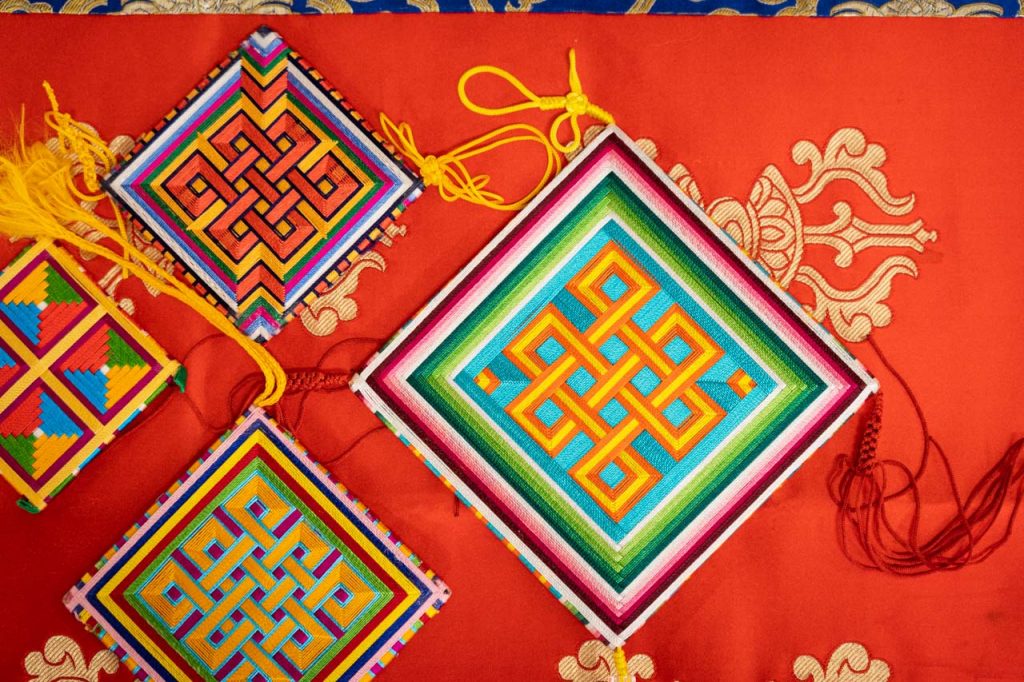
“For people who don’t have faith, they might feel this is just a form of superstition and the idea of carrying an amulet may sound ridiculous,” Jamie acknowledges. “Everyone is entitled to their opinion.
“But it’s not blind superstition. We believe in the rituals that were passed down by Buddha himself.”
Still, she is careful to caution that everyone might carry the same amulet or participate in mass ritual prayer, but the blessings each person receives depends on their state of mind.
“Are you using them for your own self-benefit, like getting wealthy to buy a big car, or are you praying so you can be in a good position to benefit others?” Jamie questions.
“If you pair a real understanding of Buddhism with a good motivation, that’s when you maximise all your blessings.“Your intentions have to be meaningful.”
Taoist Amulets in a Buddhist-Confucian-Taoist Temple: Thong Teck Sian Tong Lian Sin Sia (TTSTLSS)
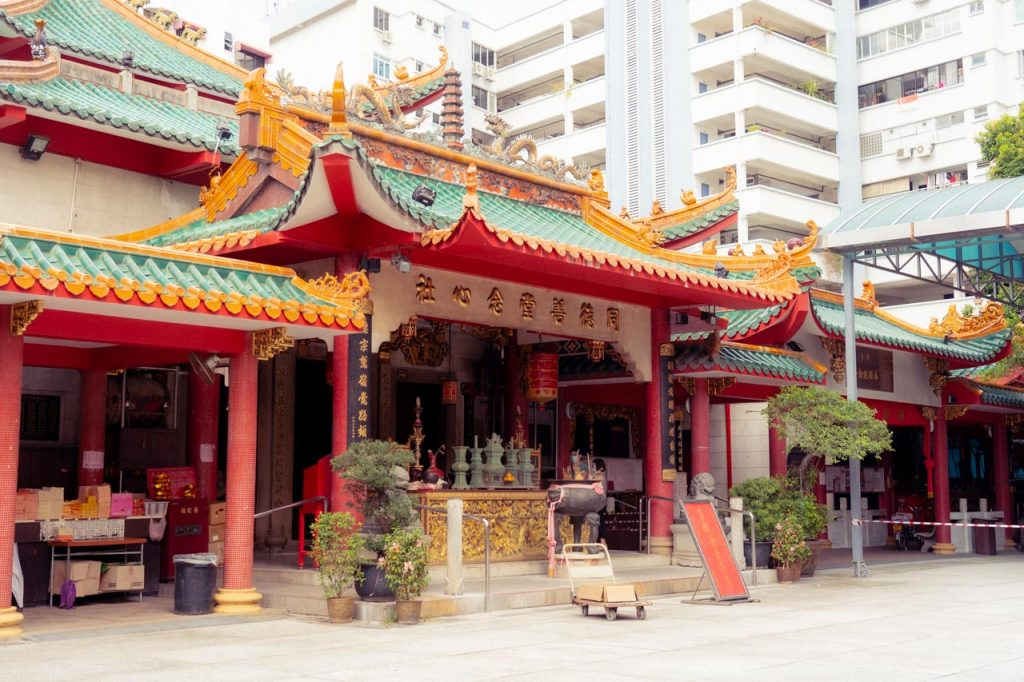
The importance of living a morally upright life and practising good deeds is echoed by Mr Goh, a caretaker at Thong Teck Sian Tong Lian Sin Sia (TTSTLSS).
TTSTLSS is a temple emblematic of the typical Chinese Singaporean’s syncretic religious beliefs because it hosts not one, not two, but three deities (镇坛师尊): Yun Jie Bodhisattva (运杰菩萨), Saint Ta-Fung (宋大峰祖师), and Lü Dongbin (one of the Eight Immortals whom Taoists worship, and who is depicted as 孚佑帝君 by the temple after he was immortalised).
Respectively, they represent Buddhism, Confucianism, and Taoism. As such, it’s not inaccurate to think of TTSTLSS as a Buddhist-Confucius-Taoist temple, though the amulets that the temple offers belong more to the Taoist tradition.
Continuing his explanation of the amulets, Mr Goh says in Teochew, “What’s important is you do no harm to other people. That way, no harm will come to you, regardless of what amulet you carry.”
My conversation with Mr Goh began, rather amusingly (and, for any journalist, terrifyingly), with him telling me there’s nothing much to tell me.
“Over here, it’s very simple. You take the amulet yourself—”
He leads me to a glass box set in front of the prayer altar, where I see four different amulets. Three have identical text and symbols printed on them, differing only in the colour of their paper: one is red, one yellow, one green. The last is yellow, one-third smaller, and contains mainly Chinese characters.

I ask him if the different amulets serve different purposes.
“All the amulets do the same thing,” Mr Goh clarifies. “They bring you peace and safety. The only difference is where you are supposed to put them.
“The red amulet is for pasting over your door. It blesses a place. Sometimes, people put it on mirrors for extra protection as we believe that mirrors repel negative energies.
“The yellow protects people. You can put it in a red packet and keep it about your person.
“If you are travelling, pick the green amulet. That is specifically for travelling overseas and will safeguard you from spiritual harm.”
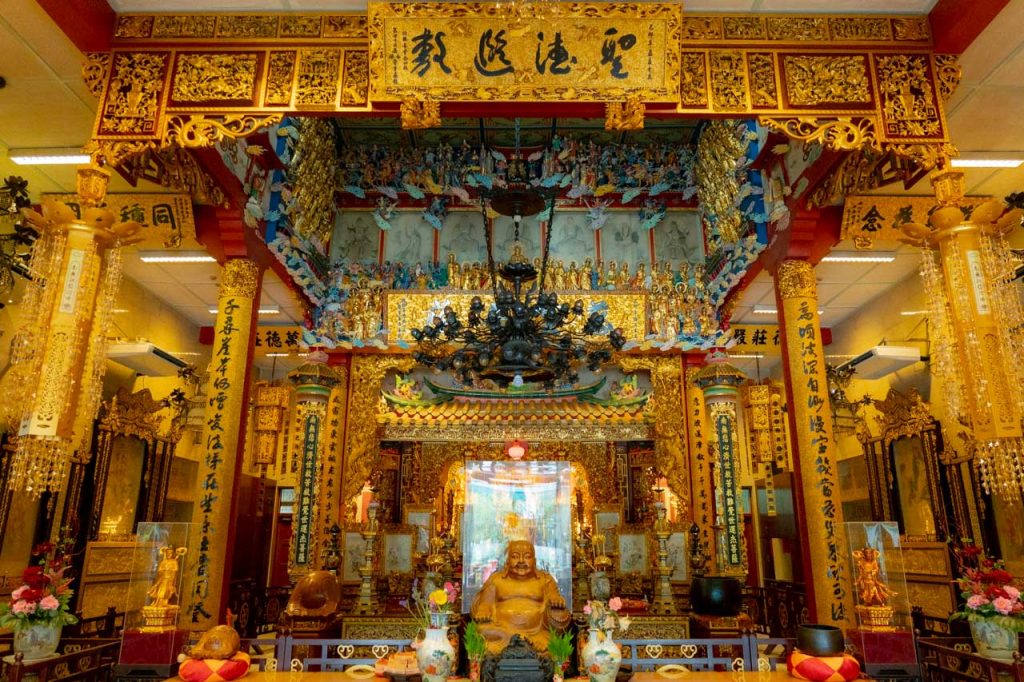
Frequent travellers can keep the amulet for up to a year, Mr Goh elaborates, after which they have to request for a new amulet from the temple while bringing their old one back to be burned. Similarly, one-time travellers have to return their green amulet once they have completed their travels.
“—so over here it’s very simple. Once you take the correct amulet,” he continues the previous thread of our conversation, “you pray to the god to bless the amulet. That’s all you have to do.”
Unlike Tibetan Buddhism, in which amulets are properly consecrated only after they have been meditated over by monks and paired with specific substances, amulets from TTSTLSS can be prepared by the lay devotee in minutes.
As Mr Goh says, all you need to do is pick the correct amulet for your purposes, bring it to the deity and respectfully prostrate yourself in front of them, while supplicating for their blessings to overcome whatever obstacle you are currently facing.
After this process is completed, the amulet is blessed and “ready for use”. Moreover, the amulets are available free to all devotees, though most, if not all, donate money after requesting an amulet from the temple.
The simplified and ground-up process is perhaps reflective of the organic way Chinese religion evolved in Singapore. Without a formal authority or religious figurehead in early Singapore, immigrants pooled funds together to set up temples by themselves, in the process amalgamating various beliefs and incorporating deities from the community into their worship.

I realise we had not talked about the small yellow amulet, so I ask: “What about the small one?”
“Oh, that?” he responds. “That one you drink.”
“You what?!” I exclaim.
“You burn the amulet. Then you put the ashes in water and drink it. It is for people who feel very uncomfortable, as if something is wrong with their body or mind.”
It seems almost too easy to receive blessings and amulets in the Taoist tradition. But Mr Goh cautions that there are practices, anathema to the religion, that devotees have to avoid.
Primary among them are three dietary restrictions. Bearers of the amulets are forbidden from eating beef, carp (鲤鱼), and turtle.
Devotees believe in honouring cattle—essentially, oxen and cows—because they help humans with arduous physical chores, says Mr Goh. Therefore, as a sign of respect for their labours, devotees should refrain from consuming any meat derived from cattle. However, the prohibitions against consuming carp and turtles are more rooted in mythology than in historical fact.
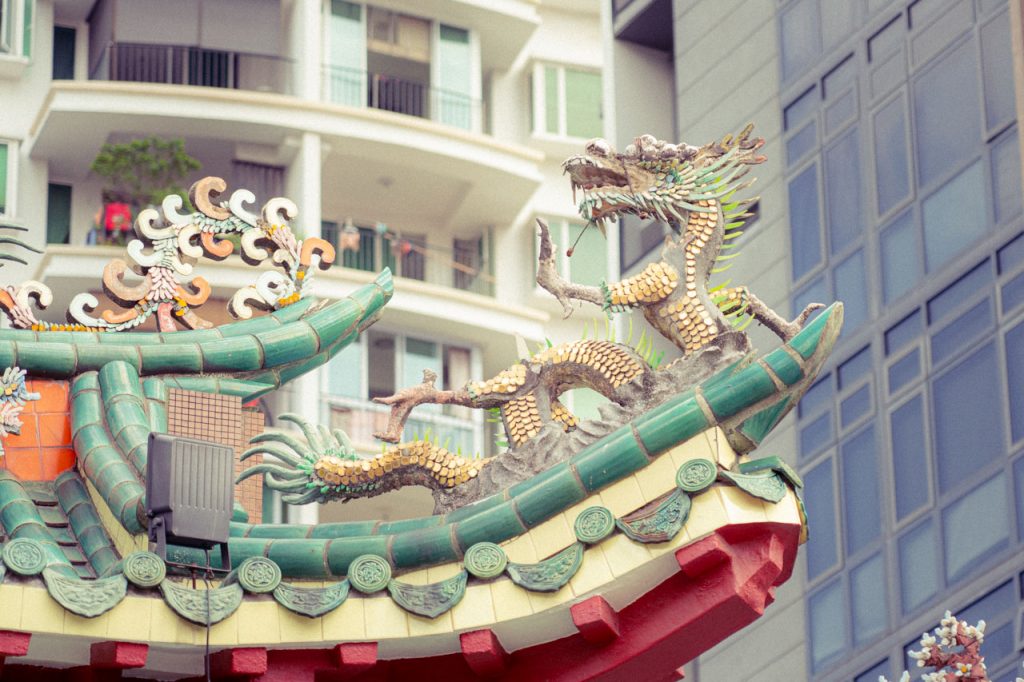
As Mr Goh is more a practitioner of religion than a scholar, he is not as familiar with the recorded history of Taoism as he is with the day-to-day routines and myths that structure the religion.
Thus, to find out more about how the history and scriptural teachings of Taoism bear on the religion’s use of amulets, I turn to Taoism, a book written by Hsiao-Lan Hu, who is a professor of religious studies.
According to the book, the founder of Taoism as an organised religion (rather than a philosophy) is Chang Tao-ling. The practice of preparing amulets—or talismans, as they are known in Taoism—Hu writes, can be attributed to Chang:
Tradition records that [Chang Tao-ling] met Lao-tzu (already deified by this time) on a mountain, and Lao-tzu taught him how to prepare a medicine that could render him immortal. Holding the secret to immortality, Chang Tao-ling was nevertheless concerned about the life of the common people; therefore he founded a religious organization, created various talismans, and subdued or dispelled malicious spirits for the followers.
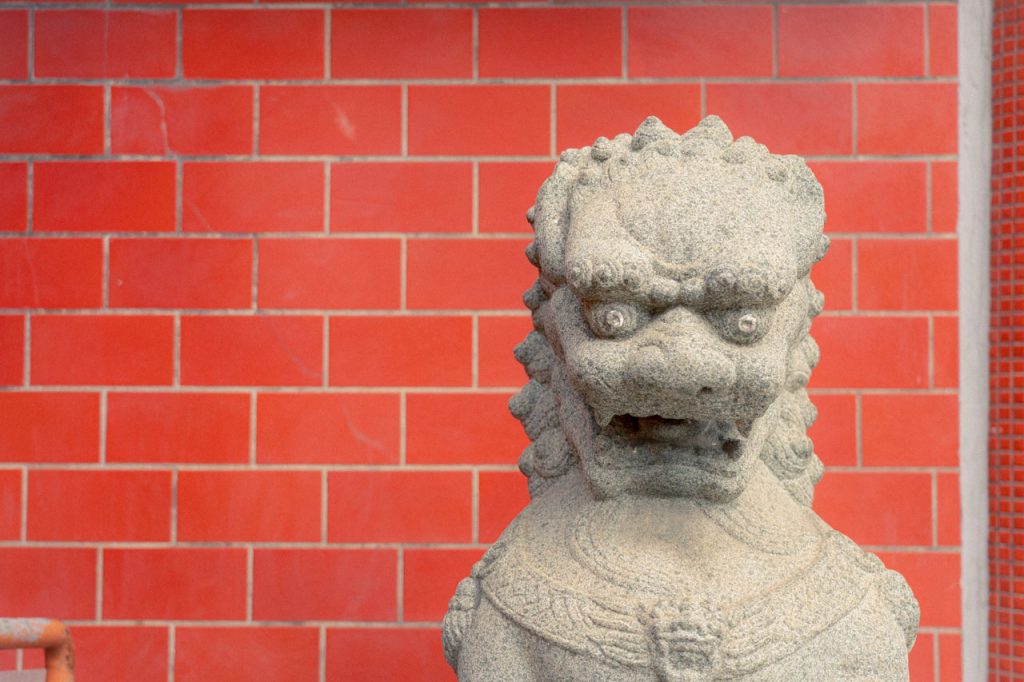
Stemming from Chang’s teachings, Taoist amulets thus became popular among devotees. They believe that “words and drawings on Taoist talismans … contain the fundamental energies of the cosmos and thus have the power to transform reality,” explains Hu.
She goes on: “The talisman writer or artist usually finishes the entire drawing in one sitting, and the words and drawings are often symmetrical.”
Indeed, talisman writing has become such a ubiquitous Chinese cultural practice that it has escaped the realm of religion and “become an important branch of Chinese calligraphy”.
Like Buddhism and Confucianism, Taoist practices and beliefs— an emphasis on “circularity and balance”, a striving towards universal truth—have permeated Chinese culture so much that Taoism is almost inextricable from many Taoist and Buddhist people’s everyday life.
As Hu notes, “Few Chinese-speaking people identify themselves exclusively as Taoists, yet much of their daily life involves Taoist beliefs and many of their customs are Taoist in origin … [such as] T’ai-chi (Taiji) and Ch’i-kung (Qigong), Chinese medicine and acupuncture, feng shui and the Chinese Zodiac, and ancestor worship.”
This is why many scholars have classified Buddhism, Confucianism, and Taoism under the broad umbrella of “Chinese religion”, as this article mentions in the beginning.
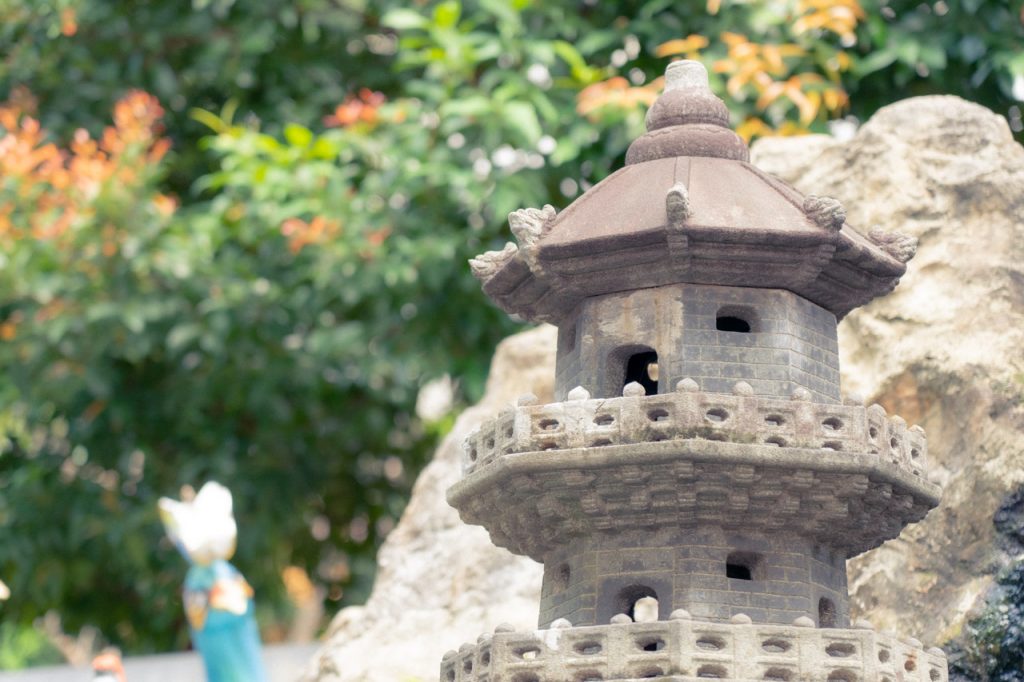
Thus, the task of cleanly demarcating the boundaries between each Chinese religion’s beliefs in, and use of, amulets, or even general practices and worldview, is almost impossible.
But there are similarities among all of them. Their temples offer devotees a safe haven from the world and a physical space to commune with the divine; their religious items, such as amulets, grant believers blessings and protection from negative forces.
That said, no religion promises its devotees miracles.
Anyone who turns to religion—whether it’s Buddhism, Taoism, Christianity, Islam, or any other religion Singaporeans practise—purely for the sake of material gains or problem-solving will be disappointed.
At the core of all religions is, after all, the practice of compassion and kindness—that is why Geshe-la, Jamie, and Mr Goh all end their conversation with me with a reminder to do good.

